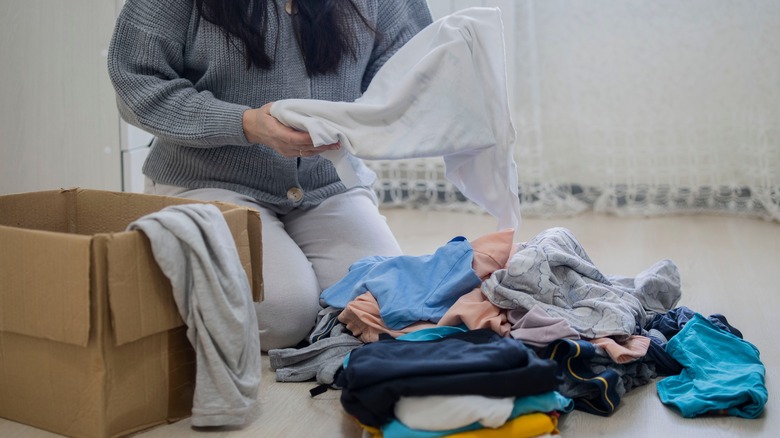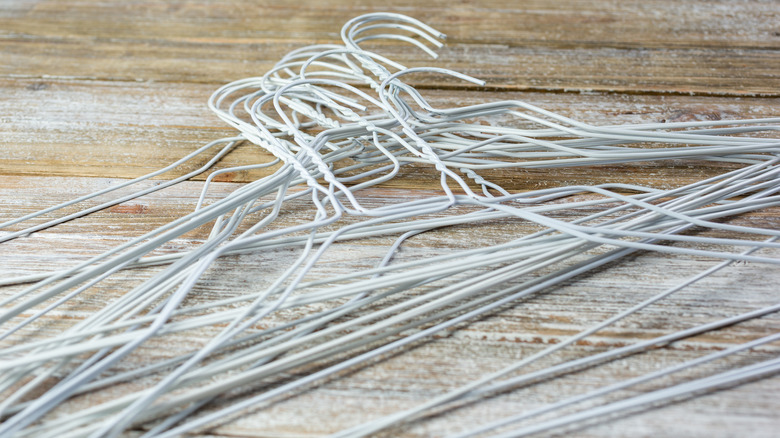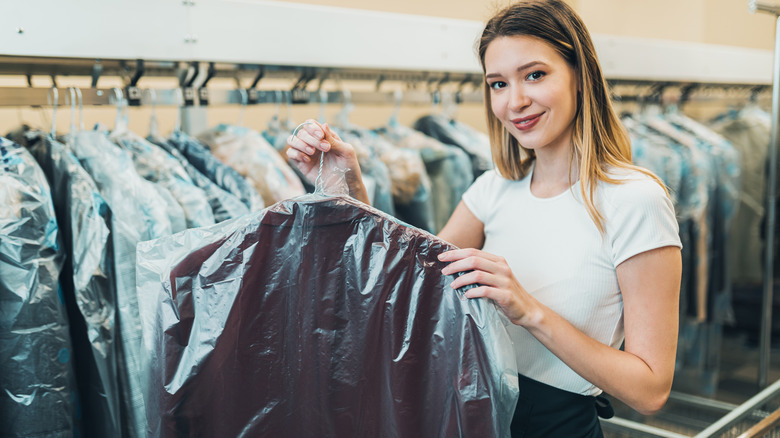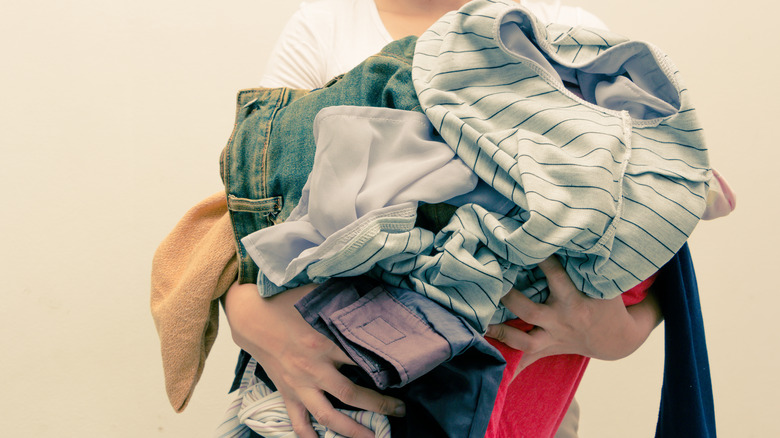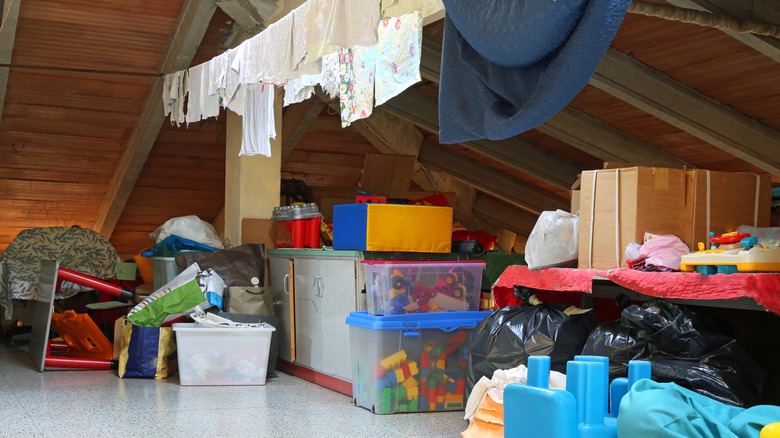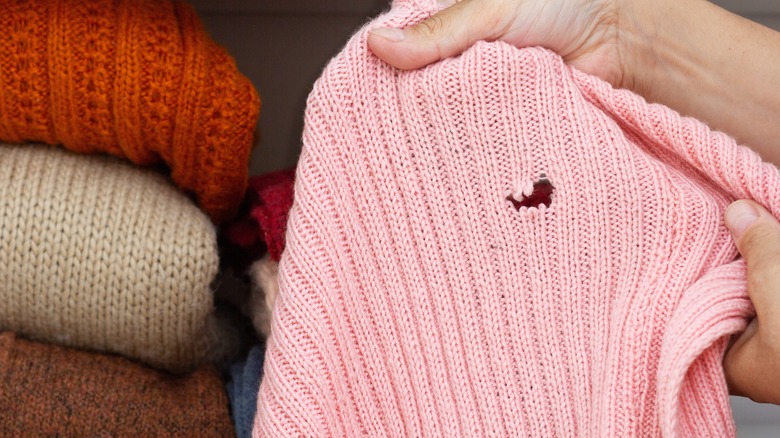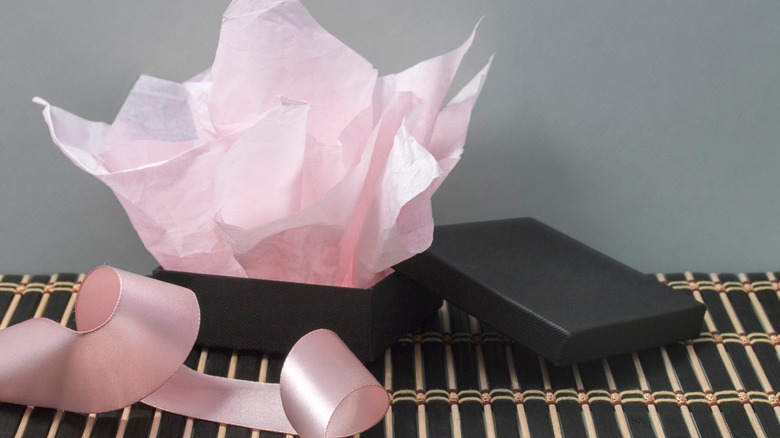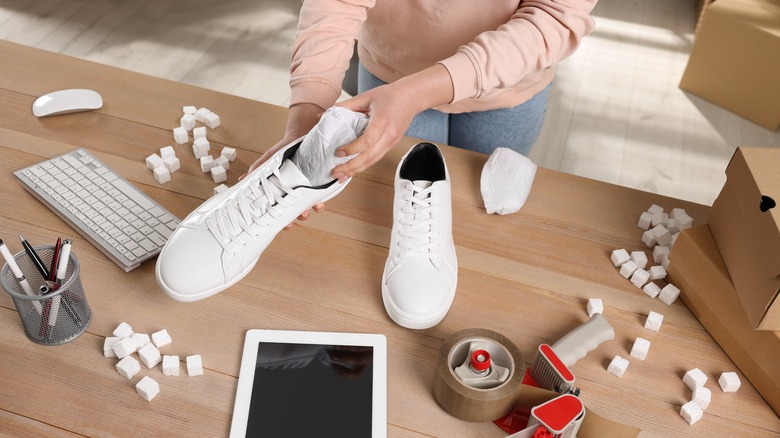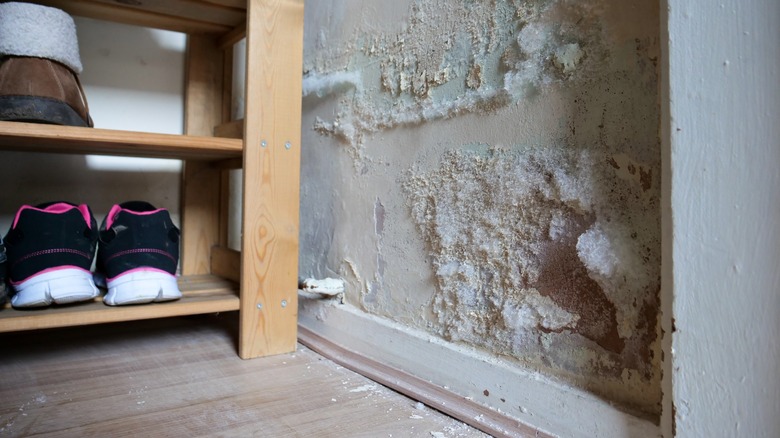Laundry Storage Mistakes That Are Ruining Your Clothes
If someone asks you how you take care of your clothes, you most likely talk about how you wash them. While this is part of it, what about storage? The way you store all your clothing is just as important as how you clean them. Storage isn't just about keeping the closet organized, either; it's learning to keep your clothing in like-new condition to extend how long you can wear them. It's common to make simple but critical mistakes when you store your clothing without realizing you're doing it.
Instead of scrutinizing how you fold or hang your clothes, think about the small things you do that can slowly wreck your wardrobe. From keeping your items in a space that is far too humid to hanging heavy garments on wire hangers, these errors can cause stretched fabric, mold or mildew growth, or discoloration that breaks down the fabric quicker. Along with being expensive to replace, you impact the environment by tossing these things into the garbage much sooner than you'd like.
Understanding these common mistakes helps you protect your clothes and keep them looking fresh and new for years. Take a hard look at how you store your clothes and rethink everything you've learned so far. Open yourself up to the possibility that you may have to change a few parts of your clothes-storing techniques to safeguard your wardrobe.
Using wire hangers to store heavy clothing
Using wire hangers to store your heavier coats or suits makes sense in theory, but you want to stop using them to prevent damage. They aren't always able to support the weight of a thick wool coat or suit, causing bulges or strained shoulders that affect the fit and contour of your clothing. They can also rust and leave marks on the clothing. Sharp edges can also poke into the fabric, causing snags or tears. The pressure wire hangers put on heavy clothing is slow but builds up, so your clothing can take a lot of damage before you notice it because it stresses the fibers. Heavy clothing can also bend your hangers, making them ineffective at storing bulky winter coats and dresses, jackets, and suits made of heavy fabrics like denim, canvas, or corduroy.
Instead of traditional wire hangers, use padded or wooden hangers for your heavier clothing. Wooden hangers are strong and give your items the necessary support to help them keep their shape and fit. They come with a contoured, wide design that evenly distributes your garment's weight, preventing them from distorting the fabric or shoulders. Padded hangers are a slightly softer alternative; use them with delicate but heavy items to cushion whatever you're storing to prevent damage. Both options preserve your fabric's integrity and clothing structure, keeping them in their original condition for much longer. By swapping out your hangers, you're taking an effective but simple step toward keeping your clothing in top shape, ensuring it lasts as long as possible.
Leaving clothing in dry cleaning plastic
Leaving your clothes in the plastic bags you get from the dry cleaners is a big mistake because these covers don't come designed for long-term storage. Keeping clothing in them for too long lets the plastic trap moisture, boosts the humidity, and encourages mildew or mold growth. They'll cause a musty smell and weaken the fibers, leading to a faster breakdown. Also, no air circulation can cause permanent creases or discolor some fabrics, and it can turn your clean, stored clothing into a breeding ground for odors and organisms.
Remove your clothing from the dry-cleaning plastic as soon as you get home and hang it on wooden or padded hangers to let it breathe and stop moisture from building up. For dust protection, Oceanside Cleaners recommends using cotton garment bags. They also let air circulate to keep your clothes dry and safe from mold and mildew growth. This helps keep your clothing in top condition after you dry clean it, and you're taking steps to help preserve your clothing's longevity and quality.
Exposing clothing to direct sunlight
Hanging your clothes in direct sunlight is a storage mistake that causes shrinking and damage. The sun's ultraviolet (UV) rays break down cloth fibers, making them easy targets for accidental tears. Dark or bright colors can fade, which can make expensive items unwearable. Some materials, like synthetic fibers or silk, get brittle or lose elasticity when you hang them in direct light, making them uncomfortable or ill-fitting. Sunlight's damage isn't something you can reverse, and you may end up tossing them out instead.
To shield your clothing from these effects, think about where and how you dry and store them. Instead of drying your clothing outside in direct light, hang them in a shaded spot. If you have to dry things outside, install your clothesline in a shaded area or dry your clothes in the early morning or late afternoon when the sun is less harsh. Keep your storage area in a room that gets no direct sunshine or use UV-blocking blinds or curtains. Store highly sensitive items in drawers or garment bags to protect them from light exposure.
Storing clothes without cleaning them or leather items without conditioning
Experts at the University of Arizona say storing dirty clothing allows oils, dirt, and unseen stains to set in as they sit in storage, and this gives bacteria something to eat for weeks. The residue also draws pests like moths, and they'll eat through your fabric. Oils and body sweat can break down fabric fibers, making them easier to tear. Storing leather items without conditioning them first allows for early wear and tear because leather needs moisture to stay flexible and strong. Without conditioning your leather clothes before you pop them into storage, they get brittle and can crack.
Before storing, give your clothes and leather items a full cleaning and conditioning to extend their lifespan. Wash the clothes according to the care label to get rid of dirt and body oils. This will prevent any unseen stains from bonding to the fibers. To clean and condition your leather jacket before you store it, you'll need to wipe on a leather conditioner. This quick process puts natural oils into the jacket to ensure it doesn't dry out and crack. Store your items in a dry, cool place in cloth garment bags to keep dust off and shield them from sunlight. This will keep your leather soft and supple and your clothing clean until it's time to pull it back out.
Storing clothes in hot attics or garages
Putting your clothes in a hot attic or garage exposes them to temperature swings that will damage different fabric types. Heat can make garments warp and shrink, changing how your clothing fits and looks. Natural fibers like cotton or wool can contract, synthetic fibers can melt, and intense heat exposure can set in stains, making them challenging to get out. These spaces can also speed up fabric dye degradation, causing fading or discoloration. Hot conditions also encourage pests, like rodents or moths, to come and hide in and around your clothing.
To avoid having heat ruin your clothing, find a dry, cool space in your home with a stable temperature for storage. A climate-controlled spot in your house, like an interior closet or under-bed storage, is excellent. They usually have very little temperature fluctuation, and this makes them safe for a broad fabric range. Putting items in vacuum-sealed bags can also create a barrier against temperature swings, pests, dust, or moisture damage.
Ignoring pest control safeguards like cedar chips
Not thinking about warding off pests and putting cedar chips or spices into your clothes storage spot allows for lots of damage. Pests like carpet beetles or moths love stored clothing, especially anything made from natural fibers like silk, wool, or cotton. They'll lay their eggs in your clothes, and the larvae will feed on the fabric when they hatch to cause large holes. Over time, an infestation causes a huge amount of damage to your whole wardrobe, and you'll find yourself replacing your damaged items or losing sentimental garments. Pest damage also makes your clothing look ratty, affecting your confidence levels.
EcoCare Pest Control recommends putting cedar blocks or chips in your storage space or putting your items into a cedar-lined closet wardrobe to ward off pests. Cedar's natural oil content emits a strong scent that carpet beetles, moths, and other fabric-eating pests don't like, so they'll stay away. It's an eco-friendly and non-toxic way to save your clothing instead of using mothballs. Every month or so, refresh or replace your cedar blocks or chips to keep the scent strong. Also, routine cleaning will deter pests by removing eggs or larvae.
Not using acid-free tissue for delicate items
Skipping the acid-free tissue paper when you store your delicate clothing pieces is bad because the acid will slowly break down the fibers, causing yellowing, discoloration, and weak spots that are easy to tear. It'll slowly set in stains, making them very hard to eliminate and degrading your clothing's quality. This mistake undoes all the care and attention you put into preserving delicate items and causes irreversible damage.
To protect your items, experts at the University of Nebraska-Lincoln recommend layering your garments with acid-free tissue paper when you store them. It forms a thin, protective barrier that helps keep your clothing's shape, color, and fabric integrity by lowering their exposure to harmful substances. Wrap them gently in acid-free tissue paper and place them in containers or drawers for long-term storage, especially for heirlooms, bridal gowns, and seasonal clothing. Consider using acid-free storage containers designed to preserve these textiles for more protection. Check on your items regularly to ensure the tissue paper stays in place, and swap it out as needed.
Not stuffing your shoes
If you don't stuff your shoes before you store them, they lose their shape and get folds or creases. Shoes, especially suede or leather, need their shape to be comfortable and look right. Without support, the material wrinkles, sags, or folds along the sides or in the toe. This distortion impacts how your shoes look when you wear them and how they fit, making them uncomfortable. Also, misshapen shoes are more prone to damage from external pressure, like stacking things on them during storage. The creases can be permanent, and they shorten your shoe's lifespan.
To keep your shoes' shape and extend their lifespan, stuff them before you store them. Use a soft cloth, acid-free tissue paper, or a shoe tree for this project. You can even repurpose old newspapers for the job. These materials fill your shoes' interior, supporting the structure and stopping it from creasing or collapsing. Use a shoe tree for leather shoes because it absorbs moisture to keep the leather in top shape. If you want to use tissue paper or cloth, gently stuff your shoes to support them without stretching. This will help keep your shoes looking nice and feeling great, especially if you don't wear them every day. It also stops them from getting crushed. If you have the space, put them on a shoe rack or shelf to reduce the chances of something falling on them.
Storing clothes in a damp or humid environment
Storing clothes in a damp or humid space (above 80% humidity) gives mold and mildew the perfect space to take hold, and these tiny organisms thrive with moisture. They'll start growing on your clothing, and this can make them smell. Eventually, they'll make the colors fade and break down the fabric, so it falls apart much faster than you expect. Along with these superficial problems, mold or mildew can be dangerous to your health if you have an allergy or sensitivity to it.
To stop it, find a cool, dry spot in your house to store your clothes. Ideally, it'll be an area where you can stack airtight containers or vacuum-sealed bags of clothes to lock moisture out and prevent mold and mildew from taking hold. For more protection, drop two or three silica gel packets into each bag or container before you seal them, as they absorb excess moisture. If you have space, run a dehumidifier to help keep the space around your clothing dry and less hospitable for mold and mildew. Also, air out your storage space at least once a month and look for moisture damage or water buildup to ward away damage. To remove mold from clothing, pre-soak them with vinegar and wash them like normal on the hottest setting possible before drying them and putting them into your storage boxes or bags.
Bundling your socks
When you bundle your socks, you fold one over the other to create a ball, which damages the fibers and elasticity. It may seem like a convenient storage method to save space and keep pairs together, but you shouldn't bundle your socks because it stretches the bands, causes shape loss, and makes a loose fit. Once the elastic stretches beyond what it's supposed to, the socks will start slipping down inside your shoes as you walk. The constant pulling and stretching you do to bundle and unbundle your socks wears the fabric down, leading to holes or thinning. This negatively impacts how your socks look and shortens how long they last.
Instead of bundling, lay your socks flat together and fold them in half or gently roll them without stretching the elastic. This helps keep pairs together without stressing the fabric and ensures your socks keep their shape and elasticity while helping them last longer. Use small boxes or drawer dividers to sort your socks by type, color, or activity level, making grabbing the right pair at a glance easier. If you have specialty socks, like silk or compression, lay them flat in a dedicated spot to ensure they stay in top condition.

